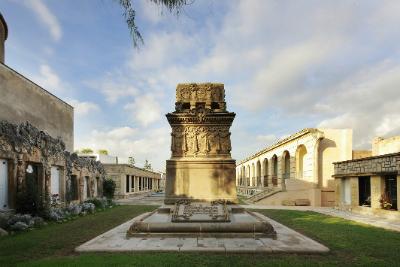The Cemetery of Vilanova i la Geltrú is nominated for the 'Best Architectural Monument' award in Spain

August 9, 2016 – The Cemetery of Vilanova i la Geltrú is a finalist in the third edition of the Spain Cemeteries Contest, in the category of Best Architectural Monument. For this nomination, Vilanova has presented the mausoleum of writer, journalist, and politician Víctor Balaguer (1824-1901), featuring a Neo-Gothic structure with Modernist sculptural elements. It is the most important mausoleum in the Garraf cemetery and one of the most beautiful, original, and symbolic of the Catalan Modernist funerary legacy.
In this edition, Víctor Balaguer's mausoleum competes in its category with nine other funerary monuments from across Spain, notable for their artistic value, significance, or preservation. Voting for the best candidate is open to the general public until September 30, 2016, via the website of the contest organizer, Adiós Cultural, at www.revistaadios.es.
In addition to Best Architectural Monument, the contest includes three other categories: Best Cemetery, Best Story, and Best Environmental Initiative. In the latter, another Catalan cemetery, El Prat de Llobregat, is also featured. Like Vilanova i la Geltrú, it is publicly owned and managed by Àltima, a funerary group with over 300 years of experience in the sector.
A Funerary Monument Full of Symbolism
The Cemetery of Vilanova i la Geltrú boasts a rich funerary artistic heritage, primarily from the late 19th and early 20th centuries, which is why it is part of the European Cemetery Route of ASCE – Association of Significant Cemeteries of Europe. Among the most significant funerary monuments in the site is the mausoleum of Víctor Balaguer, designed in 1905 by architect Bonaventura Pollés. This mausoleum is characterized by its trapezoidal shape, reminiscent of the pylons of Egyptian temples. However, one of the most notable and admirable aspects of this mausoleum is its symbolism.
The mausoleum features an inscription in Latin: patria, fides, amor (homeland, faith, love), a motto of the Jocs Florals, the Catalan poetry competition promoted by Balaguer. At each cardinal point of the mausoleum are represented the coats of arms of Vilanova i la Geltrú, Barcelona, Catalonia, and Castile and León, reflecting Balaguer's political roles in various locations across Spain.
Other symbols related to writing are found at the top of the monument: the lyre, symbolizing the poet, and the quill, an allegory for the writer. Various plant elements are also visible, such as branches – pagan in origin, symbolizing death in winter and life in spring; the palm – symbolizing the purity of the soul; the laurel – representing the soul's victory over corporeal death; and multiple flowers and plants like the poppy or the opium. Closely related to Freemasonry, the monument includes symbols such as the man, which in Pythagorean school signifies perfection – considering Víctor Balaguer was a Freemason who reached the 33rd degree, the highest; the five-pointed star, representing the five senses; or the owl – the mausoleum is supported by four of these birds – symbolizing wisdom and good fortune but also, as a nocturnal bird, announcing death. Although linked with Freemasonry, these three elements are also present in Catholic religion, to which Balaguer was devoted.
Finally, the monument displays the epitaph in Spanish: Sin amor para mí, lo tuve para todos (Without love for myself, I had it for everyone), significant of the writer’s altruistic life and personality. In Latin, it also features his name and that of his wife, Manuela Carbonell, their dates of birth and death, and mentions their wish to be buried in Vilanova i la Geltrú.